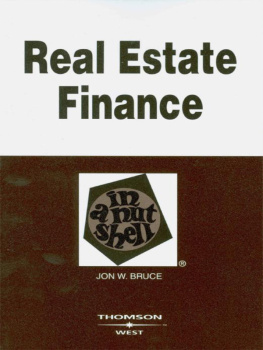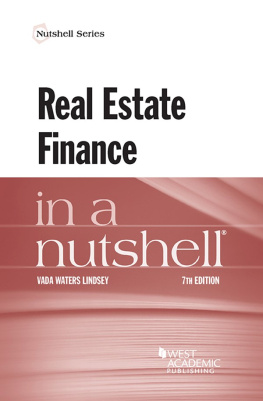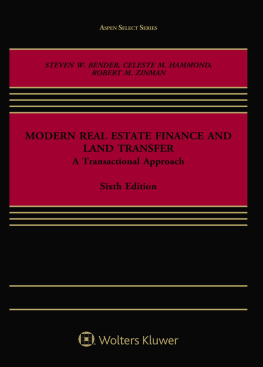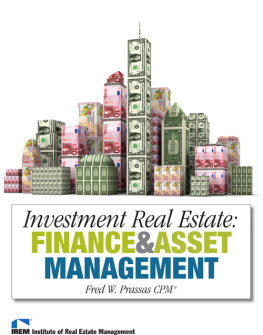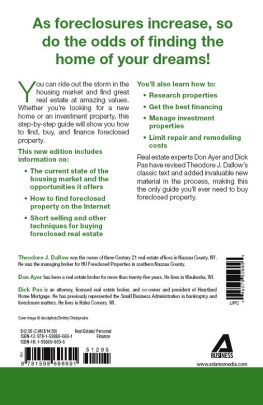WESTS LAW SCHOOL
ADVISORY BOARD
_________
JESSE H. CHOPER
Professor of Law,
University of California, Berkeley
JOSHUA DRESSLER
Professor of Law, Michael E. Moritz College of Law,
The Ohio State University
YALE KAMISAR
Professor of Law, University of San Diego
Professor of Law, University of Michigan
MARY KAY KANE
Professor of Law, Chancellor and Dean Emeritus,
University of California,
Hastings College of the Law
LARRY D. KRAMER
Dean and Professor of Law, Stanford Law School
JONATHAN R. MACEY
Professor of Law, Yale Law School
ARTHUR R. MILLER
University Professor, New York University
Professor of Law Emeritus, Harvard University
GRANT S. NELSON
Professor of Law, Pepperdine University
Professor of Law Emeritus, University of California, Los Angeles
A. BENJAMIN SPENCER
Associate Professor of Law,
Washington & Lee University School of Law
JAMES J. WHITE
Professor of Law, University of Michigan
I
REAL ESTATE FINANCE
IN A NUTSHELL
SIXTH EDITION
By
JON W. BRUCE
Professor of Law
Vanderbilt University

Mat #40617120
II
Thomson/Reuters have created this publication to provide you with accurate and authoritative information concerning the subject matter covered. However, this publication was not necessarily prepared by persons licensed to practice law in a particular jurisdiction. Thomson/Reuters are not engaged in rendering legal or other professional advice, and this publication is not a substitute for the advice of an attorney. If you require legal or other expert advice, you should seek the services of a competent attorney or other professional.
Nutshell Series, In a Nutshell , the Nutshell Logo and West Group are trademarks registered in the U.S. Patent and Trademark Office.
COPYRIGHT 1979, 1985, 1991 WEST PUBLISHING CO.
West, a Thomson business, 1997, 2004
2009 Thomson/Reuters
610 Opperman Drive
St. Paul, MN 55123
18003139378
Printed in the United States of America
ISBN: 9780314183545

III
To my wife
Barbara Edmonson Bruce
*
V
PREFACE
_________
This book is a concise textual treatment of the law of real estate finance. It is designed primarily to help law students negotiate a law school course on the subject. Other members of the legal community may use this work as a general reference and starting point for research. A table of secondary authorities is included to acknowledge sources and assist readers who desire more information about a topic introduced in this volume.
The material in this book is organized into detailed outline form for two reasons. First, the format is utilized to give students a thorough overview of the subject and a set of pegs upon which to hang information gleaned from classroom discussion. Second, the relative rigidity of this style helped me resist the urge to write a treatise-like work complete with mountains of footnotes. Such a volume, of course, is inconsistent with the purpose of the Nutshell Series. Exhaustive discussion, therefore, has been sacrificed in favor of summarization and clarity. Readers are requested to keep this in mind while proceeding through these materials.
One final word about the book. Real estate finance is like most property law, overgrown with rules. The principles, of course, are stated here, but so are the underlying theories. This approach is intended to afford VI readers a better understanding of doctrine as well as an opportunity to begin critically examining it.
I wish to say thanks to the following peoplemy wife Barb for her patience and understanding during the preparation of all six editions of this book; John Stark and Dan Sterner of the Indianapolis bar for giving me an excellent introduction to the practice of real estate finance law; Doug Mulligan, my research assistant on the first edition, for his tireless efforts; Jim Gillespie for his encouragement and helpful comments on the first edition; Scott Sartin, my research assistant on the fourth edition, for his conscientious assistance; Jim Ely, a Vanderbilt colleague, for his valuable suggestions about the third through sixth editions; law librarians, editors, faculty-support staff, and others for their help with this and prior editions.
JON W. BRUCE
Vanderbilt Law School
November 2008
VII
OUTLINE
_________
VIII
C. Mutual Savings Banks
IX
X
Chapter 3. Real Estate Financing Devices
XI
XII
XIII
B. Mortgaging Separate Interests in Same Land
XIV
XV
C. Federal Home Loan Bank Board Regulations
XVI
1. Nonnegotiable Obligation
XVII
XVIII
III. Right to Possession and Rents
XIX
XX
III. Selected Issues
XXI
A. Parties Defendant
XXII
XXIII
I. Background
XXIV
XXVII
REAL ESTATE FINANCE
IN A NUTSHELL
SIXTH EDITION
*
CHAPTER 1
INTRODUCTION TO LAW OF REAL ESTATE FINANCE
This introductory chapter presents an overview of the law of real estate finance. Because the mortgage is the cornerstone of real estate finance, it is the focal point of this chapter and for that matter the entire book.
I. MORTGAGE CONCEPT
A. DEFINITION AND DESCRIPTION
A mortgage is the transfer of an interest in land as security, usually for the repayment of a loan, but occasionally for the performance of another obligation. The typical mortgage transaction is relatively uncomplicated. A landowner borrows money from an institutional lender and enters a written agreement with the lender that the landowners real estate is collateral for the loan. In legal terminology the landowner-borrower is a mortgagor, the lender is a mortgagee, and the agreement is a mortgage. If the mortgagor fails to pay the mortgage loan, the mortgagee may enforce its security interest by using appropriate foreclosure procedures to have the mortgaged land sold to satisfy the debt. (In all of the illustrations in this book MR refers to the mortgagor and ME refers to the mortgagee).
B. OBLIGATION/SECURITY DISTINCTION
A mortgage exists solely as security for an underlying obligation, ordinarily a promissory note. See Ch. 4, pp. (considering necessity for underlying obligation and form of obligation). Consequently, every mortgage lives, travels, and dies with the obligation it secures.
Illustration : MR executes a promissory note and a mortgage to ME. ME assigns the note to A, but through inadvertence fails to assign the mortgage to A. Nonetheless, the mortgage follows the note into As hands by operation of law. See Ch. 7, pp. (discussing assignment of mortgage loan).
Illustration : MR executes a promissory note and a mortgage to ME. MR pays ME in full. ME returns the note to MR, but ME does not release the mortgage. ME has no further rights under the mortgage. The security interest created by the mortgage lapses when the underlying debt is satisfied. See Ch. 4, pp. (analyzing discharge of obligation and mortgage).
C. STATUTE OF FRAUDS
A mortgage, as the transfer of an interest in land, falls squarely within the scope of the Statute of Frauds. Thus, mortgages, as well as agreements to execute mortgages, must be in writing to comply with the Statute. Equitable principles, however, may dictate that a mortgage arises by operation of law or is enforceable even though it is unwritten.

